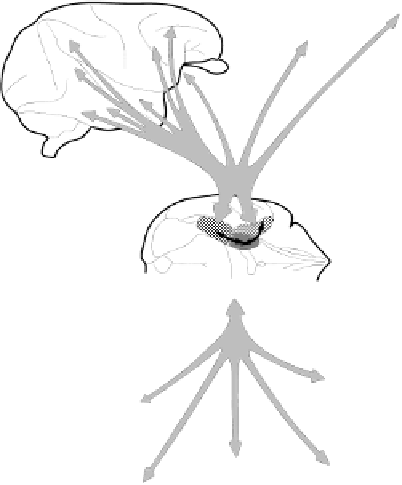Information Technology Reference
In-Depth Information
of sparse, pattern separated representations to enable
rapid sequential learning of arbitrary associations with-
out suffering from the kinds of interference problems
we just observed. This system is the topic of the next
section.
9
46
23
7
8
19
11−13
22
21
20
9.3
The Hippocampal Memory System
Perirhinal
Cortex (35/36)
The preceding explorations have set the stage for the
hippocampal memory system by demonstrating the
strengths and limitations of the cortical memory system.
Thus, we can understand the function of the hippocam-
pus and related structures in terms of a tradeoff dis-
covered in the standard cortical model — learning new
things rapidly requires that different, non-overlapping
sets of units be used to minimize interference, which is
contrary to the need for distributed, overlapping repre-
sentations to efficiently represent the underlying struc-
ture of the environment. A considerable amount of data
supports this distinction between the hippocampus and
the cortex (McClelland et al., 1995; Squire, 1992). In
this section, we will see how a model that incorporates
many important biological properties of the hippocam-
pus can perform rapid learning while suffering from sig-
nificantly less interference than a distributed, cortical-
like network. The model is based on the implementa-
tion developed by O'Reilly, Norman, and McClelland
(1998) and O'Reilly and Rudy (in press).
Parahippocampal
Gyrus (TF/TH)
Entorhinal Cortex
Cingulate Cortex
Olfactory Bulb
STG
Orbitofrontal
Cortex
Insula
Figure 9.6:
Bidirectional connectivity between the hip-
pocampus, specifically the entorhinal cortex (EC), and a wide
range of other cortical areas.
Adapted from
Squire et al.
(1989).
Figure 9.7 shows a drawing of the anatomical struc-
ture of the hippocampus, and figure 9.8 shows a simpli-
fied schematic of the principal areas and patterns of con-
nectivity, including the
dentate gyrus (DG)
,thefields
of Ammon's Horn including the
CA3
,and
CA1
,aswell
as the
entorhinal cortex (EC)
, which serves as the pri-
mary cortical input/output pathway for the hippocam-
pus. The
subiculum
is another input/output area, that
likely plays a similar role to the EC, perhaps with a
greater emphasis on subcortical and motor representa-
tions.
Anatomically, each area in the hippocampus has the
same basic excitatory and inhibitory structure as de-
scribed for the cortex in chapter 3, with the exception
of the feedback projections — the hippocampal con-
nectivity is mostly just feedforward. The ability of the
9.3.1
Anatomy and Physiology of the Hippocampus
As described in chapter 7, the hippocampus sits on top
of the cortical hierarchy, receiving a wide range of dif-
ferent types of information from various cortical areas
(see e.g., Squire et al., 1989 and figure 9.6). Thus, the
hippocampus receives inputs that represent essentially
the entire cortical state at one time (e.g., the cortical
representation of the current state of the environment).
To serve its role as a memory system, the hippocampus
must then encode this input pattern so that some frac-
tion of the original pattern can be used to retrieve the
original whole. Critically, this retrieval, which occurs
initially in the hippocampus, can spread back out to the
cortex, resulting in the reinstatement of the original cor-
tical representation.





Search WWH ::

Custom Search